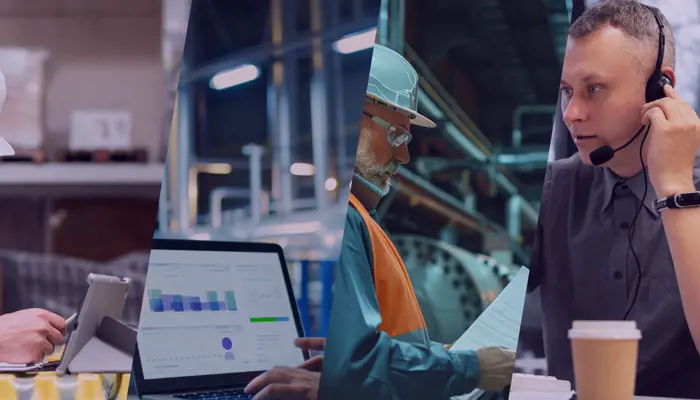
The effective ROI of a RTLS Project
IoT technologies are essential for digitising production, improving efficiency and planning. Assessing costs and benefits is crucial before investing in these technologies, considering tangible and intangible returns. Risk management, through detailed analysis and pilot projects, is vital to the success of IoT projects in manufacturing.
- IoT technologies are key to the digitisation of the manufacturing process
- Carefully evaluating costs and benefits is essential for IoT investment
- Risk management is crucial for IoT project success
IoT technologies, and localisation in particular, are crucial for the digitisation of a manufacturing process, especially when it is characterised by a high movement of semi-finished products, materials and goods. Being able to create a true picture of the production progress, aligning production planning, the sales department and suppliers for the procurement of materials and parts, allows for better management of production capacity and important returns in terms of efficiency, customer satisfaction and, ultimately, profits.
As with any innovation project, once you have focused on the problem you want to solve, you need to make an assessment of the costs/benefits of the investment required and the return on investment to be made. In general, the introduction of these technologies is typically part of a process of digitisation of the production process, aimed at collecting data that over time will allow greater control of production activities and a better link with the planning and management part of the orders.
In this article we will discuss some of the main aspects that IT managers, production managers (or more generally those who have to approve the investment) must take into account in this type of evaluation. We will give some indications on the criteria with which to assess the return on investment and the aspects to take into account when assessing (and mitigating) the associated risks.
Would you like to read the full version? Download it here
Return on Investment (ROI)
Return on investment analysis is used to assess how soon the investment made in RTLS infrastructure and services will be amortised, and when the benefits will outweigh the costs. This type of evaluation is often not easy, since on the one hand, one is not always able to measure the economic impact of a given problem, and on the other hand, the fact that these technologies can have an impact on several business functions, even if the function that initially benefits from the services offered is unique.
Listed below are some criteria by which a benefit-cost analysis can be carried out. This is primarily a methodological approach, as each case is different and each company follows its own digitisation path.
- Time horizon: It is important to assess the time horizon over which one is going to make this type of assessment. RTLS projects, or IoT in general, have a start-up cost, which may be followed by an operational cost depending on the cost model chosen (e.g. SaaS vs. on-premise). This horizon can typically vary from a minimum of 1 to a maximum of 3 years, depending on the project to be implemented and the problem to be solved. It is however important to define this value and base subsequent evaluations on it.
- Starting from known problems: The starting point of these projects is a specific need, related to a problem that one wants to solve. From there, an evaluation of the potential benefits starts, based on measurable or estimable data. For example, the time spent searching for assets, the number of assets lost, or the efficiency of equipment (OEE). For each of these issues, we should be able to give an estimate of the economic impact over the relevant time horizon. This estimate is the starting point in the return assessment.
- Add the less known (or more complex) problems: IoT technologies (and in particular RTLS) have a very broad field of application, as they can create visibility and transparency on different aspects of a production process. It is therefore important to assess from the outset how the proposed technology can, over time, support other aspects of operations. This is especially because the incremental cost of adding a new service is often marginal compared to the investment made in hardware.
- Do not underestimate the less tangible returns: There are some benefits that are difficult to measure, but whose impact can be very important. For example, a given service can contribute to the well-being of the worker, with benefits in terms of productivity and bonding with the company. For example, optimising the search for assets can have important benefits for the worker and the planning of activities.
- Also consider hidden costs: Being able to manage many aspects of production in real time and monitor the progress of production makes it possible to streamline various activities, especially those related to industrial automation. Some examples are the digital and automated management of floor warehouses, automated reordering and workplace safety.
Would you like to read the full version? Download it here
Risk management
Once an initial cost/benefit assessment has been made, and the decision to start the project has been taken, it is nevertheless essential to provide for project risk management so that timely action can be taken where necessary. Here are some fundamental aspects to be taken into account in this analysis.
Requirements analysis and planning
Requirements analysis and planning are two necessary activities to be able to evaluate the project in all its details. This is because one typically starts with a high-level analysis, on the basis of which one arrives at an estimate of the project. This initial assessment must necessarily be followed by an in-depth activity, where the project specifications are defined in detail and the final solution is designed. This activity, which is typically part of the executive project, generally involves an in-depth examination of the following aspects of the project
- An in-depth survey of the implementation area on the basis of which the final design of the IoT or location infrastructure is provided. In this assessment, the actual environment is evaluated, taking into account any constraints or complications, e.g. relating to cabling
- An in-depth IT assessment, covering security aspects, e.g. corporate policies, virtual servers, etc.
- Necessary integrations, e.g. with ERP, MES or WMS, have to be investigated in detail. This may require the involvement of external parties (such as the application supplier) or the realisation of dedicated interfaces. It is therefore necessary to document very well how the applications realised will integrate with existing systems.
- The complete specification of the application part: it is important to define exactly what is expected from the application, taking into account aspects related to usability by all those involved and the intended use.
- KPIs: any metrics identified for the success of the project (and the return on investment) must be defined in detail, specifying how and when they will be measured, and with what expected values. In this way, the goodness of the project and the value provided for the customer can be measured.
Pilot project
The pilot is a fundamental step to start the project on a limited scale (and cost). It is important that the pilot project is sufficiently representative of the intended application scenario and that it is implemented in the production environment. Through the pilot project, any doubts about the realization of the overall project, and the use of the technology, should be removed. Aspects to be addressed during the pilot project are, for example, the performance of the tracking system in the real environment and its usability.
Choice of supplier
Choosing suppliers with proven field experience is crucial for IoT/RTLS projects. These projects require experience through which one is able not only to put the system into operation, but above all to support the customer in making choices along the way, managing the associated risks and identifying the best solution to respond to a given problem.
In conclusion, the implementation of IoT and localisation technologies offers significant opportunities to improve digitisation in manufacturing processes. The evaluation of costs and benefits, together with the careful management of risks through detailed analyses and pilot projects is a crucial step for the success of such initiatives. Finally, the choice of experienced suppliers becomes essential to effectively guide this digital transformation in industry.
Would you like to read the full version? Download it here

